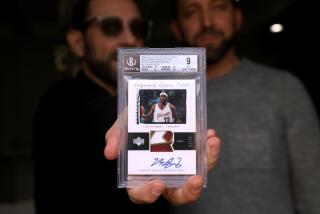Kids Told to Pocket Their Pokemons
- Share via
PELHAM, N.Y. — Pikachu, Jigglypuff and the other mutating monsters on the Pokemon juggernaut are running into roadblocks at grade schools around the country.
The hot-selling trading cards that capitalize on the Japanese cartoon phenomenon have been banned, restricted or discouraged by some principals in New York, New Jersey, Washington and elsewhere because they’re distracting the early-reading set.
In Pelham, just north of New York City, all four grade schools have come down in some fashion on the cards, which have sold in the millions since they came out in January.
“They seem to be the latest craze, and the children are beginning to become obsessed by them,” said Gerard Finelli, the principal at Colonial school. Finelli has banned trading between pupils “because some of our younger kids were getting suckered out of their more valuable cards.”
The cards are banned entirely at Prospect Hill school, where principal Richard Limato said, “We were having instances in which the children were losing them and then getting very upset.”
Kevin Wolski, a second-grader at Colonial, has about 60 of the cards, a poster illustrating all 150 of the sometimes cuddly, sometimes scary monsters, a Pokemon comic book, a T-shirt and a pin. The 7-year-old doesn’t bring his cards to school anymore because “the teachers don’t like it and the principal said he’d better not catch us trading.”
Besides, he said, wide-eyed, “Somebody was stealing them!”
Like millions of other kids, Kevin jumps out of bed to watch the Pokemon cartoon each morning and can converse rapidly and astutely on the details of the trading-card game: about the gentle goldfish Magikarp, who can evolve into the powerful sea serpent Gyarados; about Psyduck, whose powers increase “if he has a really bad headache”; and about Kadabra, “who can hypnotize lightning bolts when his eyes light up.”
Kevin’s mother, Linda, has no objections to her son’s new obsession, noting that the cards encourage kids to read, the game requires some arithmetic skills, and the cartoon takes pains to teach lessons, “like making fun of the vanity of the villain.”
Kevin’s father, Mike, likes that among the big-eyed human characters, “boys and girls are equally powerful.”
The Pokemon phenomenon originated in Japan three years ago as a Nintendo Game Boy game. Until recently, it was best known for the cartoon episode that sent 700 Japanese viewers to hospitals when they reacted, some with epilepsy-like spasms, to a scene that flashed bright colors in rapid succession.
Undaunted, Pokemon quickly expanded into cartoons, comic books and the trading cards, which are made by Seattle-based Wizards of the Coast under a license from Nintendo.
Wizards spokeswoman Carol Rogalski said the targeted age for the cards was 8 to preteen, but kids 5 and 6 have been collecting the cards as well.
“It’s just turned into this hottest thing,” she said, and the cards are headed for a fifth printing.
The rarest cards sell to collectors for more than $50, but a starter set with 61 cards has a suggested retail price of $7.99. Other packs have list prices of $2.79 to $9.99, but there have been markups to $20 or so, Rogalski said.
More to Read
The biggest entertainment stories
Get our big stories about Hollywood, film, television, music, arts, culture and more right in your inbox as soon as they publish.
You may occasionally receive promotional content from the Los Angeles Times.










